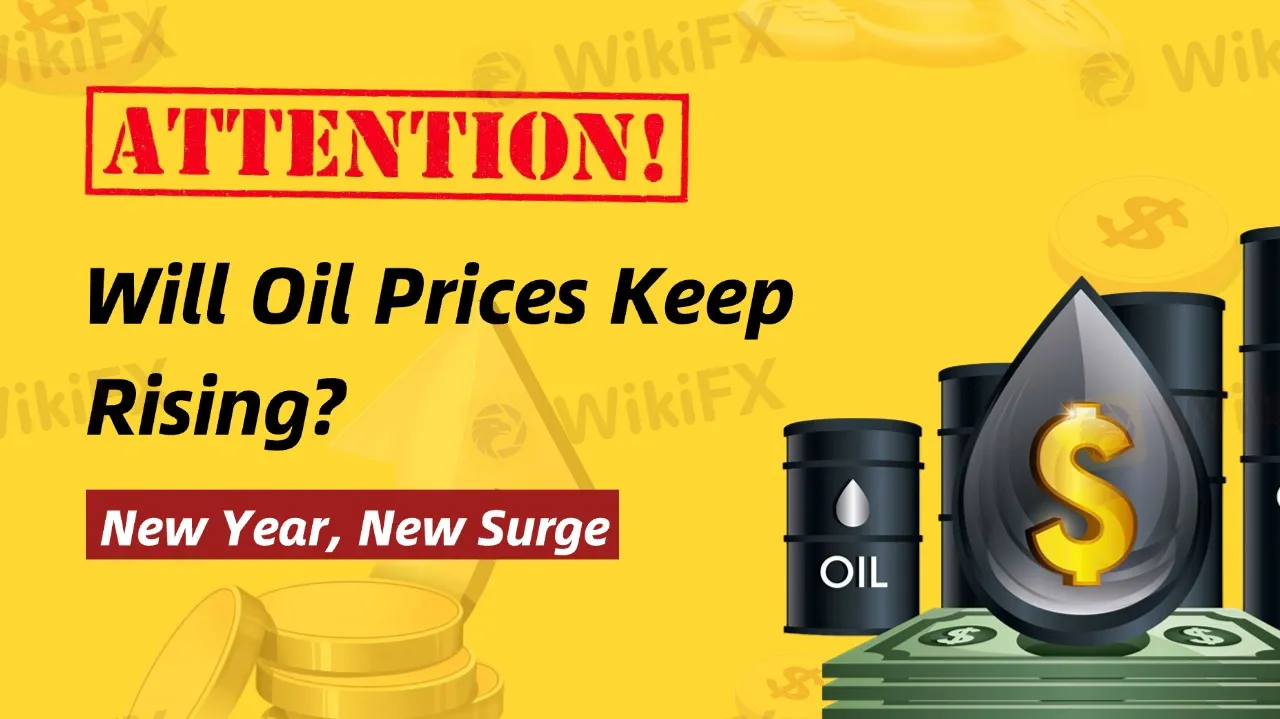简体中文
繁體中文
English
Pусский
日本語
ภาษาไทย
Tiếng Việt
Bahasa Indonesia
Español
हिन्दी
Filippiiniläinen
Français
Deutsch
Português
Türkçe
한국어
العربية
New Year, New Surge: Will Oil Prices Keep Rising?
Abstract:As of the writing of this article (January 2), oil prices stand at $71.88 per barrel. Investors need to continue monitoring whether the supply and demand dynamics will continue to push prices further up.

The outlook for crude oil supply in 2025 remains uncertain, but the short-term increase in demand has driven oil prices higher.
Oil price fluctuations are influenced by multiple factors, primarily including global supply and demand dynamics, geopolitical risks, crude oil inventory levels, and OPEC+ policies. Since the beginning of last year, OPEC+ has implemented production cuts, which have helped support oil prices.
However, between July and September, oil prices fell sharply due to a de-escalation in geopolitical risks, especially with the progress of the Israel-Palestine ceasefire talks, as well as capital market shocks that suppressed the valuations of risk assets like crude oil.
Geopolitical Influence
On the supply side, geopolitical tensions have provided some support for oil prices. If geopolitical tensions ease in 2025, this support could weaken, and oil prices may face downward risks. Investors should remain cautious about the potential for prices to drop again.
This week, attention should be focused on the EIA (U.S. Energy Information Administration) inventory data. According to the data released on December 31, U.S. oil production increased by 259,000 barrels per day in October, reaching a record high of 13.46 million barrels per day, driven by a surge in demand—the strongest since the pandemic.
The EIA forecasts that U.S. oil production will rise to a new record of 13.52 million barrels per day this year. However, some analysts believe that supply could tighten this year, particularly due to the policies of President-elect Trump, including sanctions on Iranian oil exports, which may provide short-term support for oil prices.

Impact of Fed Rate Cuts
At the same time, according to CMEs “FedWatch” tool, the probability of the Federal Reserve keeping rates unchanged in January 2025 is 88.8%, while the chance of a 25 basis point rate cut is 11.2%.
Typically, when the Federal Reserve cuts rates, the U.S. dollar depreciates, which in turn tends to push oil prices higher. Rate cuts increase market liquidity, lower borrowing costs, and stimulate economic demand, thereby driving up both oil demand and prices.
However, oil prices will still be affected by a combination of factors, including global economic conditions and geopolitical risks, so a comprehensive analysis of various dynamics is necessary.

Disclaimer:
The views in this article only represent the author's personal views, and do not constitute investment advice on this platform. This platform does not guarantee the accuracy, completeness and timeliness of the information in the article, and will not be liable for any loss caused by the use of or reliance on the information in the article.
Read more

The Daily Habits of a Profitable Trader
Every professional trader follows a structured approach to ensure they are well-prepared, disciplined, and able to seize opportunities with confidence. Whether you are a seasoned investor or an aspiring trader, adhering to a robust daily checklist can significantly enhance your performance. Use this checklist to check if you are a qualified trader

How a Housewife Lost RM288,235 in a Facebook Investment Scam
A 47-year-old housewife in Malaysia recently fell victim to an online investment scam, losing a substantial sum of RM288,235 after engaging with a fraudulent scheme advertised on Facebook.

A Trader’s Worst Mistake: Overlooking Broker Reviews Could Cost You Everything
In today’s digital age, reviews influence nearly every decision we make. When purchasing a smartphone, television, or home appliance, we pore over customer feedback and expert opinions to ensure we’re making the right choice. So why is it that, when it comes to choosing an online broker where real money and financial security are at stake many traders neglect the crucial step of reading reviews?

Interactive Brokers Launches Forecast Contracts in Canada for Market Predictions
Interactive Brokers introduces Forecast Contracts in Canada, enabling investors to trade on economic, political, and climate outcomes. Manage risk with ease.
WikiFX Broker
Latest News
TradingView Brings Live Market Charts to Telegram Users with New Mini App
Trump tariffs: How will India navigate a world on the brink of a trade war?
Interactive Brokers Launches Forecast Contracts in Canada for Market Predictions
Authorities Alert: MAS Impersonation Scam Hits Singapore
Stocks fall again as Trump tariff jitters continue
INFINOX Partners with Acelerador Racing for Porsche Cup Brazil 2025
Regulatory Failures Lead to $150,000 Fine for Thurston Springer
April Forex Trends: EUR/USD, GBP/USD, USD/JPY, AUD/USD, USD/CAD Insights
March Oil Production Declines: How Is the Market Reacting?
Georgia Man Charged in Danbury Kidnapping and Crypto Extortion Plot
Currency Calculator







